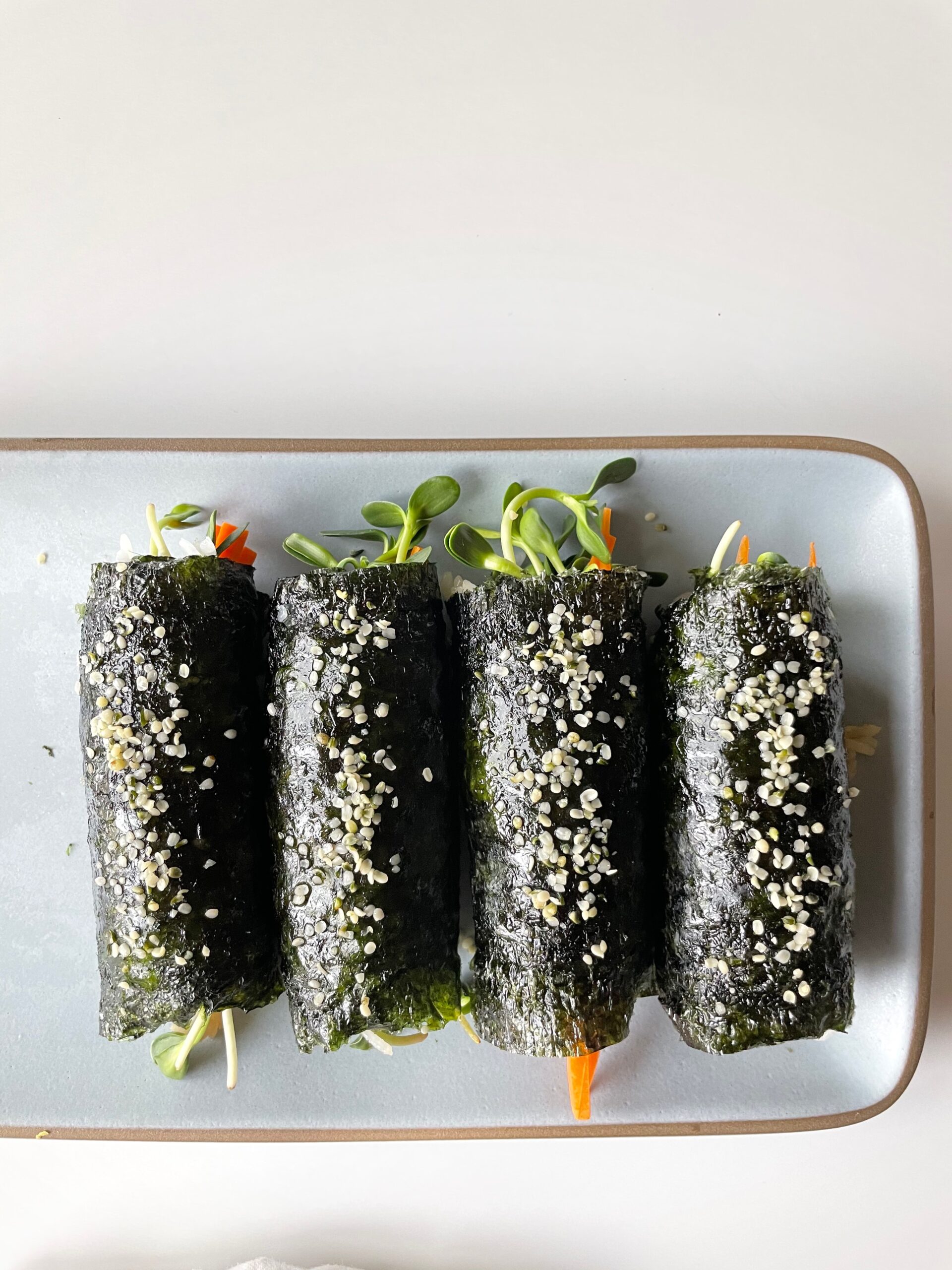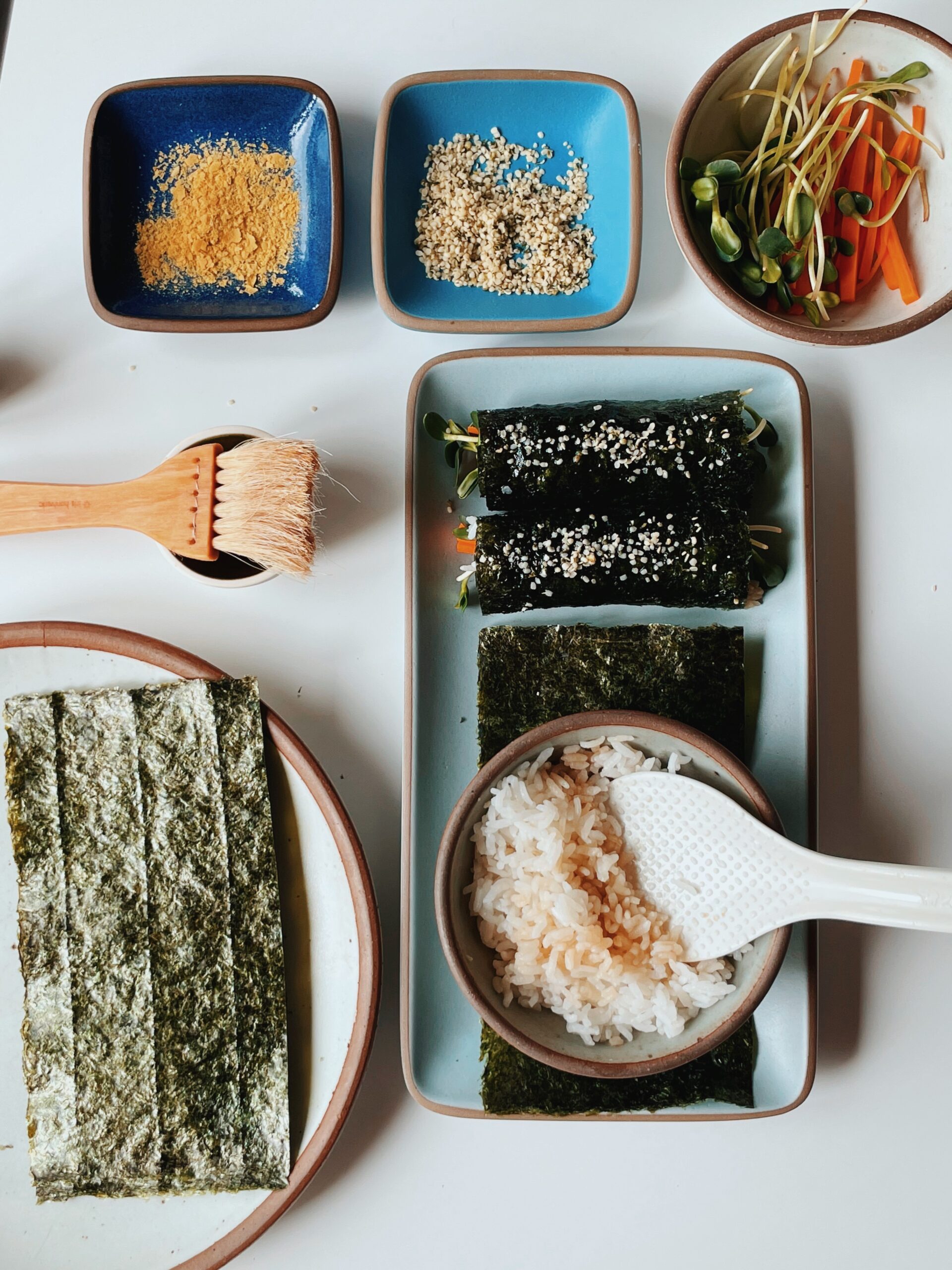

There are lots of little snacks to pack for big bike rides.
These are a new favorite of mine.
As the weather is warming, we’re playing outside more, and we’re all thinking a little bit more about what we’ll eat when we get home from our adventures…or what we’ll eat ON our adventures (or maybe it’s just me?) I’m headed out for a big bike ride in the mountains today, and I’ve been thinking all week about what I’ll take with me. These Little Kimbap (or Mayak Kimbap) are what I landed on…and my sense is that they’re not at all what you would ordinarily think of when you think of “ride food.” But this (or something like this) is the first thing I think of.

I started riding very long distances (120+ miles in a day) while living in Southern Japan. I would pack yen in my jersey and stop at the convenience stores on my route to pick up onigiri and these became the first “long ride foods” I ever knew. So while these aren’t “energy bars,” or “bites” or nuggets made with fruits and nuts and oats parading around as an unbaked muffin, they’re the first things I crave for a long day in the saddle. And one of the first things I suggest you consider making yourself.
In addition to being nostalgic for me, there are quite a few reasons to pick them as an adventure snack. These little kimbap do pass a couple of key tests that I run to ensure that they make good ride food. Here’s what I mean.
So, I’ve got a couple of critical things that I think about before I plan what to pack with me on a bike ride as a snack. First I ask myself:
How long will my ride be?
If my ride is shorter than 2 – 2.5 hours, I’m probably not taking a significant snack with me. Instead, I’ll plan to have a good meal before I go out, and to eat a meal when I come back. If I do pack a snack, it’s something really simple that won’t ruin my post-ride meal — medjool dates are a favorite for this circumstance. If my ride is 2.5 – 3 hours in duration, I’ll pack a snack for sure.
From there, during warm months, I’m looking for a food that fits one of the following criteria:
The snack has at least 20% moisture content, so that the food is easy to digest without requiring a great amount of my on-bike hydration.
Foods that don’t have at least 20% moisture content require us to drink water to digest them properly, when we don’t, we experience digestive distress. When we DO have to drink water to consume our snack, this is water that takes away from our hydration strategy on the bike. Examples of foods that are great for this are steamed rice, fresh dates, cakes, bread or pastries with higher moisture content, etc.
The snack provides salt.
When we’re exercising, our hydration strategy is just as important as our fueling strategy. They’ve inextricably intertwined actually. The purpose behind hydration is, yes, to rehydrate what we’re sweating out, but this can only happen when we’re drinking something that contains electrolytes AND the uptake of those electrolytes is helped significantly when we add a bit of sweetener. (This is why water alone is not sufficient!) Salty pretzels, or nuts, or a savory snack (such as a rice cake) can help deliver electrolytes in addition to whatever I’m drinking OR, it can deliver them in lieu of an electrolyte drink.
The snack provides carbohydrates.
When we’re exercising, our primary fuel is carbohydrates. The more carbohydrate we have onboard in our bodies, hypothetically the longer we can run or ride or play. There are several other macronutrients that help our bodies do their larger jobs, but when we’re exercising we’re monopolizing most of the attention on the activity we’re engaged in, so rather than tossing my body a macronutrient that it doesn’t have the bandwidth to digest properly, I focus on giving carbohydrates when I’m in motion, and proteins or fats when I’m home and enjoying a recovery meal.
The snack is portable.
And there are lots of ways to make this happen. I’ve absolutely been on bike rides where buttered noodles in a plastic bag were our ride fuel and it worked like a charm.
And, of course, the snack doesn’t need to be refrigerated.
These simple mayak kimbap fit the bill for several of these criteria: the rice contains more than 20% moisture, the seasoning provides salt and carbohydrates AND, they’re easier to port than they look AND depending on what you fill your kimbap with, these rice rolls – just like rice cakes – will be fine out of refrigeration while you ride…just like rice cakes.
Lastly, it’s something that I want to eat, that works for my body.
I can’t reiterate enough that it’s of the utmost importance for you to learn what works for YOUR body, and go with it. And also, to recognize that it can change — with the seasons, as your fitness shifts, and even from year to year. Learning what foods work for your body requires trial and error, and embracing the fact that some things won’t work as well as others – and some may be a total flop while others make you feel like you could ride/run/hike forever. Listen to those cues and be a detective into your own experience.

Yes! Justine Lee shared a recipe for mayak kimbap in Bon Appetit this week, and as soon as I saw it I just knew that this was my “rice cake of the week.” I’ve literally made tens of thousands of Skratch Labs rice cakes over the years, (if you’re looking for a favorite recipe, this and this are my go-to’s.) and they remain a favorite ride food of mine. But, sometimes it’s fun to twist them and that’s precisely what these little kimbap are.
Makak kimbap (mini gimbap in Korean) are literally, seaweed wrapped rolls filled with steamed rice along with a whole magical world of fillings. Omelet-style eggs, marinated, sauteéd or grilled vegetables, kimchi, cooked fish, pickles…the list is endless. Of course, you can also simply wrap seaweed (kim) around rice (bap,) and you have a snack.
This version I share below is a very simple one, with a twist as I season the rice with a few flavor agents that make the rice irresistible. A few notes below tell you how to make it your own.
That's ok, just sign up or log in to see this recipe.